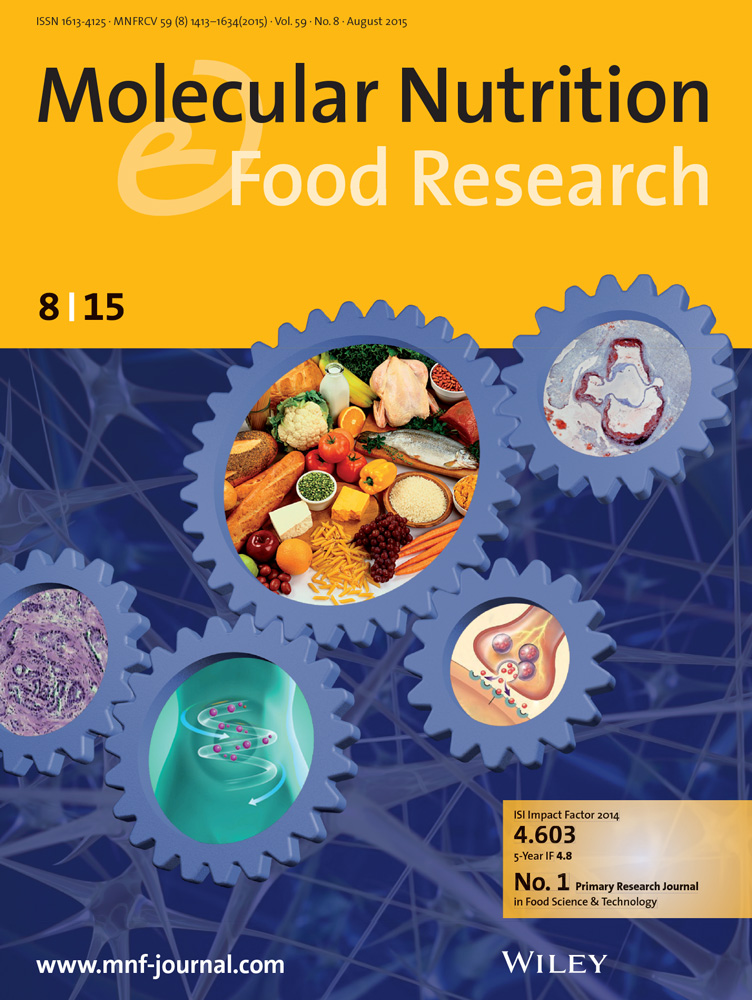EPA/DHA but Not ALA Reduces Visceral Adiposity and Adipocyte Size in High Fat Diet-Induced Obese Delta-6 Desaturase Knockout Mice
IF 4.5
2区 农林科学
Q1 FOOD SCIENCE & TECHNOLOGY
引用次数: 0
Abstract
The objective of this omega-3 feeding study was to elucidate the independent effects of α-linolenic acid (ALA) versus eicosapentaenoic (EPA)/docosahexaenoic acid (DHA) on visceral adiposity and inflammatory signaling in diet-induced obese delta-6 desaturase (Fads2) knockout (KO) mice. Male wildtype (WT) and Fads2 KO mice were fed a high-fat diet (45% kcal from fat) containing either lard (no omega-3s), flaxseed (ALA), or menhaden (EPA/DHA) for 21 weeks. Epididymal white adipose tissue (eWAT) was analyzed for changes in tissue weight, adipocyte size, triacylglycerol (TAG) and fatty acid content, and inflammatory markers. Despite no differences in final body weight, menhaden-fed mice had lower eWAT weight, smaller adipocytes, and lower TAG content compared to lard-fed mice regardless of Fads2 genotype. The eWAT of flaxseed-fed WT mice resembled menhaden-fed mice, while the eWAT of flaxseed-fed KO mice resembled lard-fed mice. No differences were observed in the expression of genes regulating eWAT inflammatory signaling (Tnfα, Nfκb, Mapk14, Mcp1, Ccl5, Tlr4, Nlrp3, or Adipoq) or the abundance of select proteins (p38-MAPK or MCP-1). In conclusion, a high-fat diet containing EPA/DHA, but not ALA, attenuates adipocyte hypertrophy and lowers TAG content but has no effect on eWAT inflammation in a mouse model of long-term diet-induced obesity.

EPA/DHA而非ALA减少高脂肪饮食诱导的肥胖δ -6去饱和酶敲除小鼠的内脏脂肪和脂肪细胞大小
这项omega-3喂养研究的目的是阐明α-亚麻酸(ALA)与二十碳五烯酸(EPA)/二十二碳六烯酸(DHA)对饮食诱导的肥胖δ -6去饱和酶(Fads2)敲除(KO)小鼠内脏脂肪和炎症信号的独立影响。雄性野生型(WT)和Fads2 KO小鼠被喂食含有猪油(不含ω -3脂肪酸)、亚麻籽(ALA)或鲱鱼(EPA/DHA)的高脂肪饮食(45%卡路里来自脂肪)21周。分析附睾白色脂肪组织(eWAT)的组织重量、脂肪细胞大小、三酰甘油(TAG)和脂肪酸含量以及炎症标志物的变化。尽管最终体重没有差异,但无论Fads2基因型如何,与猪油喂养的小鼠相比,鲱鱼喂养的小鼠eWAT体重更低,脂肪细胞更小,TAG含量更低。亚麻籽喂养的WT小鼠eWAT与鲑鱼喂养的小鼠相似,亚麻籽喂养的KO小鼠eWAT与猪油喂养的小鼠相似。在调节eWAT炎症信号的基因(Tnfα、Nfκb、Mapk14、Mcp1、Ccl5、Tlr4、Nlrp3或Adipoq)的表达和选定蛋白(p38-MAPK或MCP-1)的丰度方面没有观察到差异。综上所述,在长期饮食性肥胖小鼠模型中,含EPA/DHA而不含ALA的高脂饮食可以减轻脂肪细胞肥大和降低TAG含量,但对eWAT炎症没有影响。
本文章由计算机程序翻译,如有差异,请以英文原文为准。
求助全文
约1分钟内获得全文
求助全文
来源期刊

Molecular Nutrition & Food Research
工程技术-食品科技
CiteScore
8.70
自引率
1.90%
发文量
250
审稿时长
1.7 months
期刊介绍:
Molecular Nutrition & Food Research is a primary research journal devoted to health, safety and all aspects of molecular nutrition such as nutritional biochemistry, nutrigenomics and metabolomics aiming to link the information arising from related disciplines:
Bioactivity: Nutritional and medical effects of food constituents including bioavailability and kinetics.
Immunology: Understanding the interactions of food and the immune system.
Microbiology: Food spoilage, food pathogens, chemical and physical approaches of fermented foods and novel microbial processes.
Chemistry: Isolation and analysis of bioactive food ingredients while considering environmental aspects.
 求助内容:
求助内容: 应助结果提醒方式:
应助结果提醒方式:


